Lauren - Not Yet In Her Little Red Dress
Saturday, August 15, 2009
 The surgeon looked at the adjutant-general, gravely and significantly. The patient's eyes slowly closed, and thus lay for a few moment; then, his face suffused with a smile of ineffable sweetness, he said faintly: "I suppose this must be death,"and so passed away. The surgeon looked at the adjutant-general, gravely and significantly. The patient's eyes slowly closed, and thus lay for a few moment; then, his face suffused with a smile of ineffable sweetness, he said faintly: "I suppose this must be death,"and so passed away.Parker Adderson, Philosopher, Ambrose Bierce Today was eventful but trying in many ways. I discussed the act of willing oneself to die, with a friend who has been admitted to hospital. We talked about fearing death. I mentioned Ambrose Bierce’s Parker Adderson, Philosopher who is a man ready to die in the morning but not the day before. I attended the memorial of Vancouver poet Gerry Gilbert at the Roundhouse. Gilbert died a couple of months ago and the folks who were there represented an era long gone. It was an era in which poets listened to musicians. Musicians listened to poets and painters and architects listened to musicians and poets. Now, a speaker at the memorial noted, there are many more poets but fewer that seem to be good. When I say the same thing about photographers I am told I am too critical. The day had to be a day of melancholy and it was until almost the end. I managed to get Rosemary into the car and even managed to fold a wheelchair and put it into the trunk. With Hilary we went to the airport to pick up Lauren and Rebecca. They had gone for two weeks to San José el Cabo in Baja California with our daughter Ale. Many years ago Rosemary and I would send Ale and Hilary to Mexico for several weeks to spend time with the Zamoras. It was with the Zamoras that Ale, Rebecca and Lauren visited this time. Rosemary and I always enjoyed going to the airport to see how our daughters had grown and to note their tans. It was the same all over again with our granddaughters. But there was something different – an unexpected different. Rebecca looked much the same and most lovely as usual. The little shock was Lauren. Lauren had grown and looked older and much prettier than when she had left. When we arrived at Hilary’s house the girls opened their luggage. Ale pulled out all sorts of Mexican sweets. But it, was Lauren who captured my heart. She pulled two nice Mexican dresses, one a brilliant carmine red. "I picked these dresses so you can photograph me in them," she said to me. Yes! Addendum courtesy of Brian Nation (present at Gerry Gilbert's memorial) who sent me an email with the subject "No Exit" From now on memorial attendance for dead jazz musicians, photographers, and bums only.
bNation included this photograph which I rather like which he took of me outside the memorial service. 
Winston Carlyle Miller & His Orphan Client
Friday, August 14, 2009
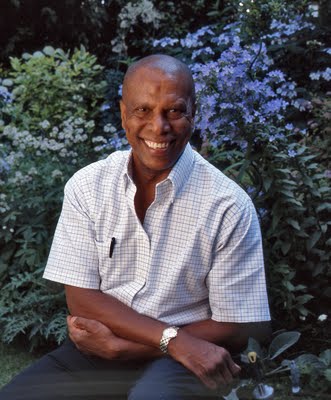 In the late 70s I had a lucrative contract taking industrial and PR photos for Canadian Pacific Limited. I took pictures of CP trucks, planes and trains. I photographed train crews fixing rail lines and once even got the chance to photograph the Royal Hudson being repaired at the Round House (now The Roundouse Community Centre) on Drake Street. The contract with CP brought me good money so I decide to attempt to double it by getting a job doing the same for Air Canada. Harry Atterton, the public affairs manager for Air Canada liked my portfolio but told me that he already had a good photographer. I left a bit glum. It was about six months later that I read in the Vancouver Sun that a photographer had died suddenly of a heart attack. He had a wife and two daughters. The daughters were about the same age as my own. It was the photographer for Air Canada. I received a call from Atterton a few days later offering me a job. Not long after I got another call (a cold call) from an life insurance agent wondering if I wanted to buy a policy. My yes was instant. I bought one. Rosemary did not like my agent citing his used car salesman qualities. I really did not care at all as long as I was insured. But then I started running into my agent at Wreck Beach. There is something odd about having a conversation with your life insurance agent when both of you are in your birthday suits. In the beginning of 1986 I received another cold call this time by a man whose voice sounded like Sidney Poitier. He asked me what kind of insurance I had and somehow he convinced me that it was the wrong one and that he would make it right. Winston Carlyle Miller looked very much like Sidney Poitier and even shared that skin colour. While Poitier was from Miami, Florida, Miller was from the more exotic Georgetown. He quietly and smoothly nudged me to cancel my former policy and to switch to his company (Transamerica). He even sold a policy to Rosemary. He calls me on my birthday and his soothing voice never intrudes that much even when I tell him how bad business seems to be for me. I photographed Miller in the garden three weeks ago. It was like having a friend in my garden. I realized I have known him for 23 years. His voice is still that voice but his Poitieresque features are perhaps less evident now. Yet as I watched Sidney Poitier in Lilies of the Field today it seemed like it was Miller who was building that chapel for the German, Austrian and Hungarian nuns. And I have to point out that Winston in his short-sleeved sports shirt looks as good as Poitier did in his.
Real Polo
Thursday, August 13, 2009
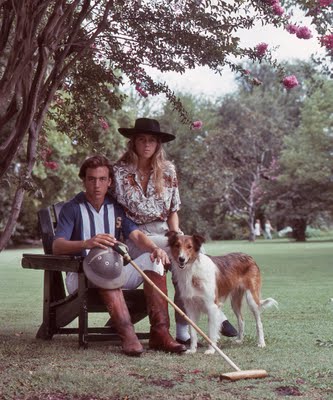 As a little boy when I accompanied my father and mother from our residential neighbourhood of Coghlan downtown we took the Bartolomé Mitre train that took us past Belrgrano R to our destination of Retiro which was the end of the line. On the way, where the two different Mitre lines (the other passed a station called Belgrano C) merged to head towards Retiro, the trains would pass by the forested Palermo Park which was and is even today full of stadiums. There were soccer stadiums, rugby stadiums, Olympic sports fields, and the Hipódromo Argentino de Palermo where the horse races were held. On weekends, when my parents often took me to the movies on Calle Lavalle, there would be games being played on the stadiums or I would see the horses on the way to the finish at the hipódromo. But the rarest and most exciting sight for me was when looking out of the window I would see the elegant and prancing ponies on the polo field. Years later when I was in the Argentine Navy I would often go to Palermo on Sundays to watch a polo match or my cousin Georgito O’Reilly play with his rugby team, Club Atlético San Isidro(CASI). I thought myself too refined to go to the many A-League soccer games being played on any Sunday afternoon. 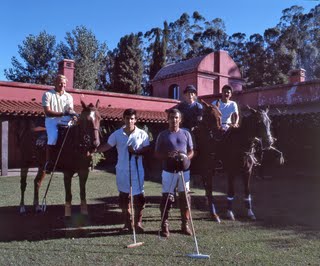 To this day I admire the look of the real Argentine polo player. The look comes surely from the fact that to play polo you need a lot of money and idle time to practice. It is the combination of idle time and practice that makes the Argentines the best polo players in the world. As I look back at these photographs I note that this is as authentic as polo can ever get. Poor old Ralph will never really get it. You see, to be authentic you have to have a bit of the gaucho. The gaucho may not have been elegant or smart but he certainly could ride that horse. 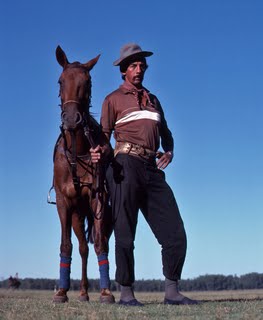
Not Taking It For Granted That It Will Always Work
Wednesday, August 12, 2009
 About once a year I am not able to transfer my photographs from my computer's hard drive into the blog using my FTP server. The problem, in every case, has been an issue with Blogger which is owned by Google. This means that technical support is non existent and even an acknowledgement that there is a problem is rarely ever posted by Blogger. I have stopped trying to see if the problem is in my computer. A way around the problem is to upload my photographs on to a web-based photo site (in my case it’s called Photobucket). Then by using the HTML address of the photo the picture appears like magic here as is the case now with a portrait of Rebecca I took last year. My fuzzy knowledge of HTML prevents me from customizing the position of the photo. About all I can do is select tiny, medium and small. Furthermore I have learned to ignore the indication from Blogger that my blog is taking longer to publish. If I wait for the publish sign it could be hours or days. I simply open my Explorer again and check my blog. The blog is published in spite of the warning that it isn't. This year's turmoil (the last five days) has coincidentally (?) happened when I experienced problems with some web sites like the Globe's and some videos from the NY Times. I decided to find out by calling Telus tech help. It took me three days before I finally got through. My call was taken by what must have been a very young cababayan of mine (a fellow Filipino countryman/woman). She did not respond directly to any of my questions. She would answer, "Can you hold? Let me ask." My question was, "Is the web or in particular Telus having speed issues in BC?" After some back and forth she finally acknowledged that it was and has been a Telus issue in BC for the last four days. There is no recording or any information on this on any Telus site. This is certainly not a rant. I have vowed not to have any on this blog. But surely customers should be informed of technical issues that prevent us from finding out why our web connection is not working properly? Surely now that checking one's e-mail every morning is as important as being able to turn on the lights in the kitchen to make breakfast should mean that Telus and other internet providers must have the same obligation as BC Hydro to satisfy its customers. Yes 120 volts, 60 cycles and 100 Mbps!
T&A No More
Tuesday, August 11, 2009
 Five years ago I went to Buenos Aires with Rosemary and Rebecca. Wherever I went I saw the near naked and young female figure advertising everything from eyewear to toothpaste. I asked my Irish nephews why this was the case. I told them that the images were almost obscene to me. My nephews were puzzled and jokingly challenged my manhood. It was some 20 years ago that I shared a show of nudes with two other photographers. My nudes included my subject’s faces. I remember that there was one salient comment in the gallery guest book, “ Alex, thank you for showing us the faces.” When possible my nudes are always also portraits. At Focal Point I have been teaching for some time The Contemporary Portrait Nude. If I were to try to explain the concept to my nephews they would smirk and comment to what lengths I go to justify taking pictures of naked women.  It is difficult to try to explain not only to my nephews in Argentina but my friends in Mexico about what has happened to the traditional male-oriented approach to sexuality or to the language men (at least in Canada with my own contemporaries) used to used to use when speaking of women. In the 80s and early 90s I was an enthusiast of female exotic dancers. I never drank in these establishments as I have never enjoyed drinking. My interest in these bars was to gaze on the female figure in all of its glory. My enthusiasm waned and disappeared one evening at the Marble Arch 10 years ago when I was there with some architect friends and a journalist. This bunch was very much in control of their drinking habit. They would invariably drink a couple of pitchers of beer and at a certain point they would stand up (extremely sober) and go home. Some were married and they were going home for supper. But on this one evening one of them told the rest, “Let’s wait to see her ti.. before we go.” I had heard this expression for years and I had never given it much thought. This time I was shocked and disgusted. I never returned and I have not seen an exotic dancer since. My nephews would laugh at me, “¡Che, necesitás Viagra! It is in the spirit of the above that a much kinder and respectful man, this man has to make a confession. In the late 70s ane early 80s I used to take still photographs of CBC variety shows. The TV cameramen and I would often ogle the female dancers that were part of the troupe called The Jim Hibbard Dancers. In particular it was Hungarian-born cameraman Michael Varga and I who really liked to compare notes. We loved staring at Viktoria Langdon. She had the most perfect legs we had ever seen or that I have ever seen since. To top the legs she had Cinemascope cheekbones and a sophisticated (to us) South African accent. Then there was Jackie Colman who had sex appeal. This term has pretty well disappeared. In the 50s men and women would say, “He or she has SA.” Everybody knew what SA was! In contemporary language you would say that Colman had bedroom eyes and sex rushed out of every pore of her body. If the minimum clothing that these dancerw was much too much we could always catch Colman at the No Five Orange sans costume. 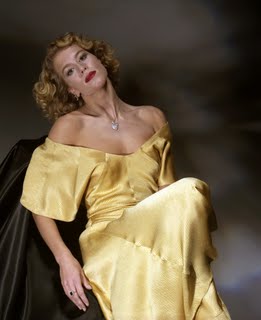 Jackie Colman had this Mezzo-soprano voice and she often spoke to us as did Viktoria Langdon. There was a third dancer who was in a different category. She was remote. When she wasn’t dancing she was preening or stretching. I was mesmerized watching her. She was like watching a spirited Arabian horse. Mike and I thought she had the most perfect bum (we used the word that is a synonym for donkey). The rest of her body was compact and her legs were beautiful.  She had a narrow, almost streamlined face. Her blond hair was wavy. In was in the mid 80s that I had my chance to photograph her in my studio for Vancouver Magazine. I used Hollywood lighting and I stupidly ( I repeat, stupidly) arranged to cover most of her body with clothing. Here she is in all her clothed glory. But there is that picture that I snipped from some contact sheet that is inside the Whalley, Moira file. I know that the dancer on the right is Whalley. I am sure that my nephews would find that picture to their liking.
Bill Featherston's Guardian Angel
Monday, August 10, 2009
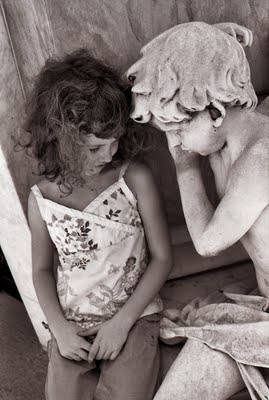 I met Vancouver painter (he lived in Brackendale outside Squamish, B.C.) around 1980. He was a jolly friend of Mac Parry who was the editor of Vancouver Magazine. Featherston was tall, well built and with his beard and baseball cap he reminded me of Hemingway. And he drank like Hemingway. One day he arrived and asked to borrow money from Mac. He told Mac that he had spent the night at a cheap local hotel after having had lots to drink. He woke up in the hotel minus his wallet. His penchant for fun and drinking he shared with other friends of Mac. One of them was Mati Laansoo who drank like a Baltic carp (he was from Estonia). It was about this time that Featherston had a one man show at the Bau-Xi Gallery (not mentioned in Featherston’s curriculum!) where he painted Mati and himself naked and the theme of the show was his hate for art critics. I remember that one of his paintings may have been called Kill The Art Critics. Nonetheless his show was given not bad reviews by the men he attacked so boldly. I observed this happy man and I wondered how he managed to drive from Vancouver, almost every day, all the way to Brackendale (one of the most dangerous highways in Canada) without a mishap. He taught at what was then called the Emily Carr College of Art. Alcohol and the Sea to Sky Highway could have never been happy partners. It was then that I found that the only explanation for Featherston’s survival (he died, not in a traffic accident, in May of this year) could only be the intervention of a most efficient and personal guardian angel. In fact I have used Featherston’s case as my proof for their existence. Since I can remember I had a little oval mirror the size of my hand (now) which had a brass guardian angel attached to it. It was pinned to my crib and then to all the little beds I had subsequently. The little guardian angel survived (and it hung behind my first daughter Ale’s crib) until 1969 when my Aunt Dolly visited us in Mexico City and saw the angel. She said it was her son Robin’s. She took it with her. I wondered and never asked how the little angel had come to be with me for so long. The little angel had been part of my life as much as a little almohadita (an ever so beautiful word that comes from the Arabic and means in Spanish a little pillow) which I had in my bed until I was 8. My mother told me that I was too old to cling to it and took it away. I grieved for days. Even now I cannot sleep unless I have two pillows- one for my head and one to hold. Rosemary stopped being jealous some 41 years ago. In the Philippines they call the pillow a man’s mistress. In pre-air conditioning times men (and women of shameless and questionable morals!) would sleep with a cooling pillow between their legs to ward off the sweat of legs caused by the stifling tropical climate of the Malayan islands.  Somehow I survived losing my childhood bed companions and it did not become an issue until Brother Edwin Reggio, C.S.C. taught us at St. Edward’s High School sometime around 1958 the pyramid of life in its "upward" goal to complexity. He started with rocks, went to slime, viruses, bacteria, insects, fish, birds, reptiles, mammals and then told us that the jury was still out that asserted that only humans had souls. Brother Edwin accepted that “lower” orders might have some sort of rudimentary soul. The Catholic Church had no arguments with Darwin as long as we believed that at some point God intervened and injected a soul into some version of early man (and Eve). From man, Brother Edwin continued with his pyramid of souls. The next were the angels and he explained the different orders, Seraphin, Cherubin, Thrones, Dominions, Virtues, Powers, Principalities, Archangels and Angels. He also explained how man was a blend of body and soul, while angels where pure spirits with imperfect souls. Only God was the very soul of perfection. All this made sense to me then. Now I find it much harder to accept the existence of that Supreme Being, and more so One that is concerned about life in one little planet in a universe of planets and stars. I am too mathematical to believe to the contrary. I won't fall for Pascal's argument in his famous wager. I first started having doubts when I thought to myself in what stage of my mother’s life I would find her if she were in heaven when I died. It seemed that the answer was as ludicrous as trying to find out how Santa Claus managed to navigate down narrow chimneys.  I find it much easier to believe in the existence of those luminous but imperfect spirits that are angels. Bill Featherston might just wink at me from wherever he might be. Or, he could be fluttering his feathers.
On Photography - Sontag's Ecology Of Images
Sunday, August 09, 2009
 The powers of photography have in effect de-Platonized our understanding of reality, making it less plausible to reflect upon our experience according to the distinction between images and things, between copies and originals. It suited Plato’s derogatory attitude towards images to liken them to shadows – transitory, minimally informative, immaterial, impotent co-presences of the real things which cast them. But the love of photographic images comes from their being material realities in their own right, richly informative deposits left in the wake of whatever emitted them, potent means for turning the tables on reality – for turning it [in italics in book by author] into a shadow. Images are more real than anyone could have supposed. And just because they are an unlimited resource, one that cannot be exhausted by consumerist waste, there is all the more reason to apply the conservationist remedy, if there can be a better way for the real world to include the one of images, it will require ecology not only of real things but of images as well.
The powers of photography have in effect de-Platonized our understanding of reality, making it less plausible to reflect upon our experience according to the distinction between images and things, between copies and originals. It suited Plato’s derogatory attitude towards images to liken them to shadows – transitory, minimally informative, immaterial, impotent co-presences of the real things which cast them. But the love of photographic images comes from their being material realities in their own right, richly informative deposits left in the wake of whatever emitted them, potent means for turning the tables on reality – for turning it [in italics in book by author] into a shadow. Images are more real than anyone could have supposed. And just because they are an unlimited resource, one that cannot be exhausted by consumerist waste, there is all the more reason to apply the conservationist remedy, if there can be a better way for the real world to include the one of images, it will require ecology not only of real things but of images as well.
The last paragraph of Susan Sontag’s On Photography, 1977
I have photographed many sports once. It's after you photograph them that you become an expert and not before. Only practice at a sport with a camera will allow the photographer to realize when peak and important moments happen. In baseball when the bat connects with the ball, at that very moment the bat and ball are at rest. The same happens in ballet and modern dance. If the photographer captures the movement before that peak of completion, the picture will most often look ungraceful. Movements have to be caught at the end.
The photographer who was an expert at this was New Zealand born American photographer George Silk (1916, 2004) who shot sports pictures for Life Magazine. I remember reading in a magazine a quote from him in which he said (I cannot quote it exactly), "I have had access to the fastest motor drives for cameras. I can shoot at 18 frames per second. I have noticed that the best shot is most often between frames." What Silk was saying is that the photographer, after some experience, is able to predict and anticipate that peak movement. A machine motor drive cannot.
When editorial photography began to languish some years ago I was forced to cut my costs wherever I could. The insurance of my cameras was the first to go. I had come to the conclusion that in owning duplicate equipment I could afford to lose half of it to theft. Then instead of charging clients for a whole box of Polaroid (20 exposures) I began to charge for the actual number of Polaroids taken. I learned, too the frugality of shooting fewer exposures with my 10 exposure Ektachrome film. At some point I freaked out an art director when I showed him an assignment I had shot with two exposures. His comment did not trouble me, "One of these works for me. But what if it didn't? You don't have enough of a range. You are going to get into trouble." I cannot remember when he ever assigned me to re-shoot anything. But I do know that I have finished assignments with half the roll of film exposed and feel it wasteful to have the film processed without shooting the rest, just in case. I have not allowed that to bother me and I have had film processed or processed my rolls of b+w film that were not all exposed. The urgency to provide a magazine with results prevented me from waiting to expose the film on other projects or assignments. But I have conserved my system of noticing as much as I can what I am about to shoot before I press the shutter.
As I watch the average person shooting their digital cameras or my students at school it is patently evident that they do not believe in Sontag's ecology of images. They shoot a lot and often. When I ask to see three of their best images many of my students have a problem selecting three.
For a while I had some of my more gullible students worried when I invented the term "etching your sensor". I told them that the constant and rapid firing of their digital SLRs would etch their expensive sensors and the repair would be expensive.
Elements of my Mamiya are 30 years old. Film cameras really did not go through the rapid obsolescence of modern digital cameras. My guess is what modern photographers save in not using film has to be set aside to buy new and improved equipment.
As a teenager I used to haunt the used cameras stores in Mexico City and I would stare and lust after those Edixas, Praktinas, Leicas, etc. I do believe that obsolete digital cameras must go to the same place that a sock in the drier goes when it mysteriously disappears.
I wonder if Sontag could have ever known that her idea of ecology of images would some day be in so critical a stage of application as it is now. So many pictures and so many of them that are the same. So many pictures and so few are essences. Plato would have deplored it all.
Above is a sequence that I took of Rebecca at a tea shop in Punta del Este, Uruguay in 2004. The final image, bottom right was the one. I stopped right there.
Photography is a system of visual editing. At bottom, it is a matter of surrounding with a frame a portion of one's cone of vision, while standing at the right place at the right time. Like chess, or writing, it is a matter of choosing from among given possibilities, but in the case of photography the number of possibilities is not finite but infinite.
John Szarkowski
|





















